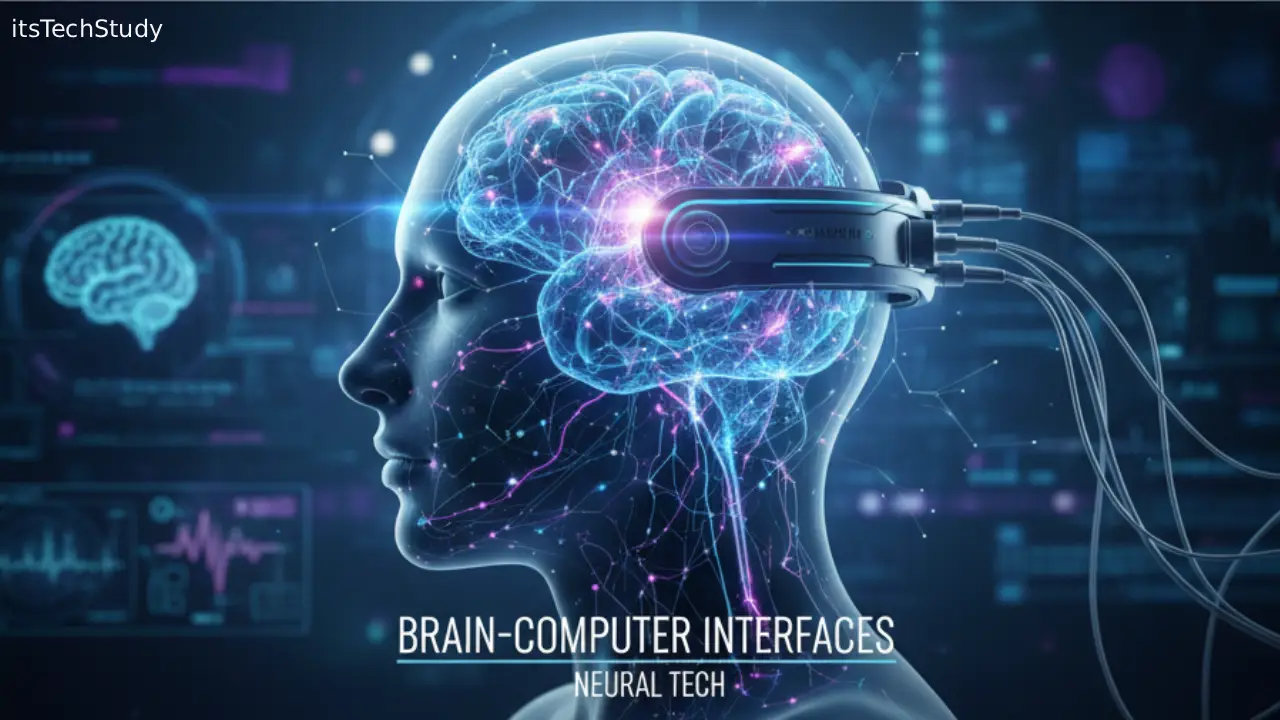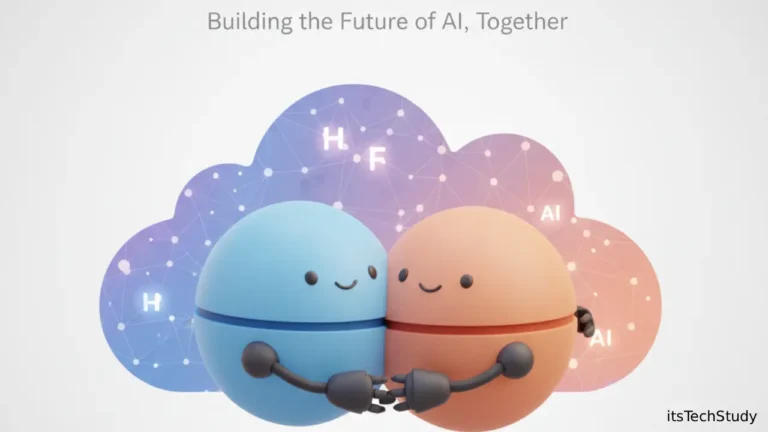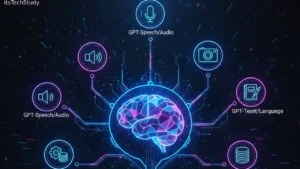Introduction: The Mind Meets the Machine
Imagine a world where you can control a computer or prosthetic limb just by thinking. No mouse, no keyboard, no voice commands – just your thoughts. What once sounded like science fiction is now rapidly becoming science fact. Brain-Computer Interfaces (BCIs) and neural technologies are paving the way for a new era of human-machine collaboration.
Over the past few decades, we’ve seen technology shrink from room-sized computers to pocket-sized smartphones. The next step, however, isn’t about smaller devices – it’s about merging technology directly with the human brain. Companies like Neuralink, Synchron, and Kernel are at the forefront of this revolution, developing systems that bridge the gap between neurons and digital devices.
But with such powerful innovation comes equally powerful challenges – ethical dilemmas, privacy risks, technical limitations, and accessibility issues. In this article, we’ll dive deep into the fascinating world of brain-computer interfaces and neural tech – exploring how they work, their potential benefits, real-world applications, and what the future may hold for humanity’s most intimate connection with technology.
What Are Brain-Computer Interfaces (BCIs)?
A Brain-Computer Interface (BCI) is a system that enables direct communication between the human brain and an external device, often a computer or robotic system. It interprets electrical signals produced by the brain and translates them into digital commands – effectively allowing thoughts to control machines.
How BCIs Work
- Signal Acquisition:
Sensors or electrodes detect electrical activity in the brain, often through EEG (electroencephalography) or implanted microelectrodes. - Signal Processing:
The raw brain signals are filtered and analyzed to detect patterns related to specific intentions or actions. - Command Execution:
The processed signals are converted into commands that a computer, robotic arm, or software can execute – such as moving a cursor or typing a word. - Feedback Loop:
The user receives visual, auditory, or sensory feedback, helping refine control and accuracy over time.
Types of BCIs
| Type | Description | Invasiveness | Common Uses |
|---|---|---|---|
| Invasive BCIs | Electrodes implanted directly into brain tissue. | High | Medical implants, prosthetic control |
| Semi-Invasive BCIs | Electrodes placed under the skull but outside brain tissue. | Medium | Neural recording, motor recovery research |
| Non-Invasive BCIs | Sensors placed on the scalp (e.g., EEG caps). | Low | Gaming, rehabilitation, mental health monitoring |
Each type offers a trade-off between precision and safety. Invasive BCIs provide highly accurate signals but involve surgery, while non-invasive systems are safer but less precise.
The Evolution of Neural Technology
Neural tech has evolved dramatically over the last 50 years – from simple EEG headsets to sophisticated implants capable of restoring mobility and vision.
Key Milestones in Neural Tech Development
- 1970s: First EEG-based communication systems developed for paralyzed patients.
- 1990s: Neuroprosthetics enable partial motor control through brain signals.
- 2000s: DARPA and major research labs fund large-scale BCI programs.
- 2010s: Commercial BCIs emerge (Emotiv, NeuroSky).
- 2020s: Companies like Neuralink and Synchron push for fully implantable, wireless, high-bandwidth interfaces.
This rapid evolution reflects humanity’s growing ambition – not just to fix what’s broken, but to enhance human abilities beyond natural limits.
Applications of Brain-Computer Interfaces and Neural Tech
1. Medical and Therapeutic Uses
Perhaps the most impactful use of BCIs lies in medicine. These systems have restored lost functions and improved the quality of life for thousands.
Examples:
- Paralysis Treatment: BCIs allow paralyzed individuals to move robotic limbs or even control wheelchairs with their minds.
- Speech Restoration: Neural implants can decode brain signals and translate them into synthesized speech.
- Neurorehabilitation: Stroke patients use BCIs for targeted brain training, accelerating recovery.
- Seizure Detection: AI-integrated neural devices monitor brain activity to predict epileptic seizures in advance.
Pros:
- Restores mobility and communication.
- Reduces dependency on caregivers.
- Opens doors to personalized neurotherapy.
Cons:
- Expensive and invasive for many patients.
- Surgical risks and long recovery times.
- Ethical issues regarding privacy of neural data.
2. Gaming and Entertainment
The gaming industry is now exploring mind-controlled gameplay. Companies like NextMind and Neurable are developing non-invasive BCIs that let players control characters or objects using concentration and focus.
Imagine adjusting your in-game power level by how intensely you concentrate — a new level of immersion is on the horizon.
Pros:
- Next-gen immersive gaming experience.
- Hands-free control for differently abled users.
- Personalized adaptive gameplay.
Cons:
- Limited accuracy in non-invasive setups.
- Possible mental fatigue during extended play.
3. Education and Learning
Neural tech is reshaping how we understand and enhance learning. BCIs can monitor student engagement and focus levels, allowing educators to adjust teaching methods in real time.
Future “neuroadaptive” classrooms could personalize content delivery based on each learner’s cognitive state.
Potential Benefits:
- Real-time learning optimization.
- Early detection of attention deficits.
- Neurofeedback-assisted education.
4. Defense and Security
Military organizations are investigating neural control systems for faster communication between humans and machines. Pilots could eventually steer drones or aircraft using thought alone, drastically reducing reaction times.
However, this domain raises serious ethical concerns – especially regarding manipulation, surveillance, or misuse of cognitive data.
5. Workplace and Productivity
Companies are exploring neuroergonomics – using BCIs to monitor worker stress, focus, and fatigue. Such systems could optimize workflows or prevent accidents in high-risk industries.
Yet, they also raise privacy issues: how much brain data should employers have access to?
The Science Behind Neural Tech
Neurons and Signals
The human brain contains around 86 billion neurons, each communicating via electrical impulses. BCIs capture these signals, often measured in microvolts, and interpret them using machine learning algorithms.
Role of AI and Machine Learning
AI is crucial for interpreting complex brain signals. Deep learning models help decode intentions, predict motor commands, and adapt to each user’s neural patterns over time – making BCIs smarter and more responsive.
Benefits of Brain-Computer Interfaces
| Category | Key Benefits |
|---|---|
| Healthcare | Restores lost sensory and motor functions; supports rehabilitation. |
| Accessibility | Empowers disabled individuals with new forms of control and independence. |
| Productivity | Enhances focus, decision-making, and efficiency. |
| Human Enhancement | Opens the door to cognitive augmentation, memory improvement, and extended human abilities. |
Challenges and Ethical Concerns
Despite their promise, BCIs face a host of technical, ethical, and societal challenges.
1. Privacy and Data Security
Brain data is the most personal data possible. Unauthorized access to neural information could expose not just what you do — but what you think.
2. Accessibility and Cost
Current BCI systems cost tens of thousands of dollars. Without affordable solutions, the technology risks becoming exclusive to the wealthy.
3. Invasiveness and Health Risks
Surgical implants pose infection, rejection, and long-term maintenance issues. Even non-invasive devices may cause discomfort during extended use.
4. Ethical Boundaries
Who owns the data from your brain? Can governments or corporations use it for surveillance or marketing? These questions remain largely unanswered.
Brain-Computer Interfaces vs. Traditional Interfaces
| Feature | BCIs | Traditional Interfaces (Keyboard/Mouse/Touch) |
|---|---|---|
| Control Method | Thought-based (neural signals) | Physical interaction |
| Speed | Potentially faster (once trained) | Moderate |
| Accessibility | Enables control for disabled users | Requires mobility |
| Learning Curve | Requires training | Intuitive for most users |
| Cost | High (for advanced systems) | Low |
Emerging Innovations in Neural Tech
1. Wireless BCIs
Companies are developing fully wireless implants, reducing infection risks and improving comfort.
2. Biocompatible Materials
New materials reduce inflammation and improve the long-term viability of implants.
3. AI-Enhanced Decoding
Next-gen BCIs leverage neural networks for faster and more accurate interpretation of brain activity.
4. Memory and Cognitive Enhancement
Research is underway on memory prosthetics that could boost or restore human memory.
5. Cloud-Connected BCIs
Imagine storing thoughts or neural data securely in the cloud for AI-assisted analysis – though this also introduces new privacy dilemmas.
The Future of Brain-Computer Interfaces
By 2035, BCIs may become as common as smartphones. With advances in nanotechnology, AI, and neuroscience, we could see:
- Non-invasive, wearable BCIs for daily life.
- AI-powered brain assistants that respond to thought.
- Augmented cognition, enhancing learning and creativity.
- Mind-to-mind communication – yes, direct telepathic exchange through technology.
But the future must balance innovation with ethics and inclusivity. Neural tech should empower, not exploit, the human mind.
Pros and Cons of Neural Technology
Pros
- Enables life-changing medical breakthroughs.
- Improves accessibility for the disabled.
- Offers potential for cognitive and emotional enhancement.
- Supports new forms of human-computer collaboration.
Cons
- High cost and limited accessibility.
- Potential misuse of neural data.
- Ethical gray areas around autonomy and consent.
- Technical limitations in signal decoding and reliability.
Conclusion: Merging Minds and Machines Responsibly
Brain-Computer Interfaces and neural technologies are reshaping the definition of being human. They promise to restore mobility, enhance cognition, and unlock entirely new forms of communication – bridging the gap between biology and digital intelligence.
But as we step closer to this interconnected future, we must tread carefully. Ethical frameworks, data protection, and accessibility must evolve alongside technology to ensure that BCIs benefit humanity as a whole – not just a privileged few.
The next great leap in human evolution won’t come from machines replacing us, but from machines working with our minds. The brain, once the last frontier of biology, is now becoming the first frontier of the digital age.
Frequently Asked Questions (FAQs)
Q1: What is the main purpose of brain-computer interfaces?
Ans: BCIs aim to create direct communication between the brain and external devices, enabling control through thought. They’re primarily used in healthcare, gaming, and human augmentation.
Q2: Are BCIs safe?
Ans: While non-invasive BCIs are generally safe, invasive ones involve surgical risks. Long-term studies are still ongoing to determine their full safety profile.
Q3: While non-invasive BCIs are generally safe, invasive ones involve surgical risks. Long-term studies are still ongoing to determine their full safety profile.
Ans: Basic consumer-level BCIs (like EEG headsets) are already available. Advanced medical or implantable systems may become mainstream within 10–15 years.
Q4: Can BCIs read thoughts?
Ans: Not exactly. BCIs detect patterns in brain activity associated with specific actions or intentions — not personal thoughts or emotions directly.
Q5: Who are the leading companies developing BCIs?
Ans: Major players include Neuralink, Synchron, Emotiv, Blackrock Neurotech, and Neurable.
Q6: What ethical issues surround BCIs?
Ans: Key concerns include privacy, consent, accessibility, and potential misuse of neural data for manipulation or surveillance.












No Comments Yet
Be the first to share your thoughts.
Leave a Comment